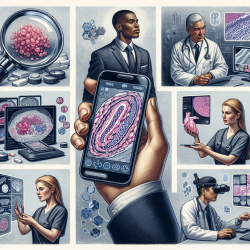Introduction
In the rapidly evolving landscape of medicine, handheld computing devices such as smartphones and tablets have become ubiquitous tools across various specialties. However, the field of pathology has been slower to adopt these technologies, despite their potential to revolutionize the practice. The review article "Handheld Computing in Pathology" provides a comprehensive overview of the current state and future potential of handheld devices in this field. This blog will explore how practitioners can leverage these insights to enhance their skills and improve patient outcomes.
Current State of Handheld Computing in Pathology
Handheld computing has a long history in medicine, with applications ranging from simple tasks like maintaining lists to complex systems for patient reminders. Despite the widespread use of handheld devices in other medical fields, their application in pathology has been limited. This can be attributed to the unique challenges faced by pathologists, such as the need to handle large data sets and high-resolution images.
Modern handheld devices are equipped with advanced hardware, including high-resolution displays, powerful processors, and connectivity options that support real-time data transfer. These capabilities make them suitable for tasks that were once reserved for high-end computing systems, such as whole-slide imaging (WSI).
Opportunities for Pathologists
The article highlights several opportunities for integrating handheld computing into pathology practice:
- Telepathology: Handheld devices can facilitate remote consultations and second opinions by allowing pathologists to share and review images and data in real-time.
- Education: The portability and connectivity of handheld devices make them ideal for educational purposes, enabling access to digital textbooks, virtual microscopy, and interactive learning modules.
- Data Management: With built-in relational databases, handheld devices can serve as both clients and servers for laboratory information systems (LIS) and electronic medical records (EMR), especially in resource-limited settings.
Challenges and Future Directions
While the potential of handheld computing in pathology is significant, several challenges remain. These include the need for high-resolution displays, secure data handling, and the development of standardized software solutions. The article suggests that future research should focus on overcoming these barriers and exploring new use cases for handheld devices in pathology.
One promising area is the use of handheld devices for whole-slide imaging. By leveraging the capabilities of modern smartphones and tablets, pathologists can view and analyze digital slides with unprecedented ease and flexibility. Additionally, the integration of voice recognition and multitouch interfaces could further enhance the user experience.
Conclusion
Handheld computing offers exciting opportunities for the field of pathology, with the potential to improve diagnostic accuracy, enhance educational outcomes, and streamline data management. By embracing these technologies, pathologists can stay at the forefront of medical innovation and deliver better care to their patients.
To read the original research paper, please follow this link: Handheld computing in pathology.










